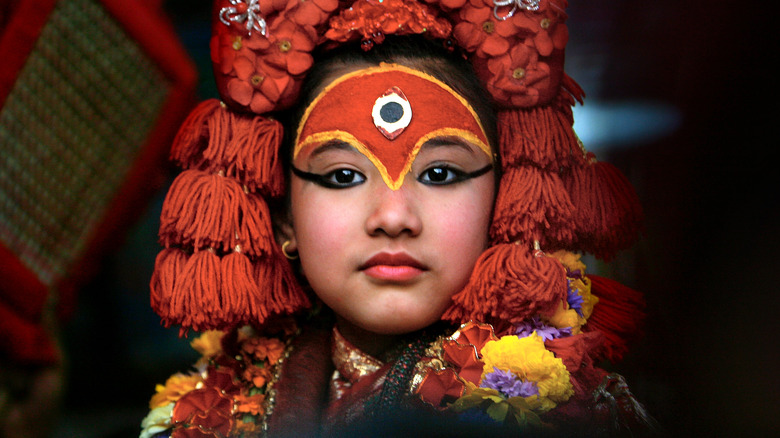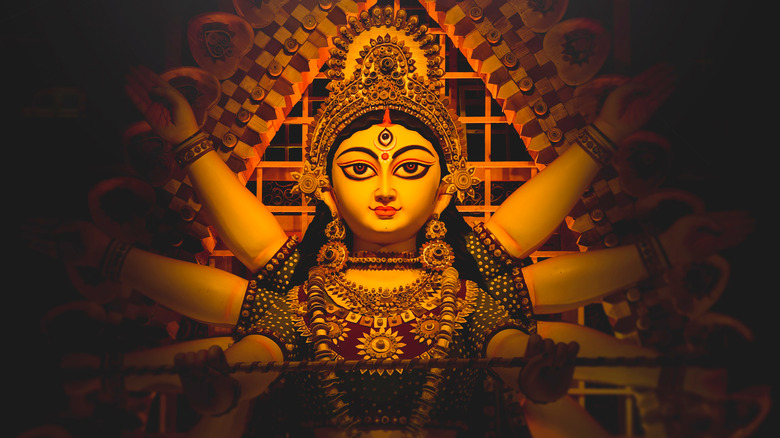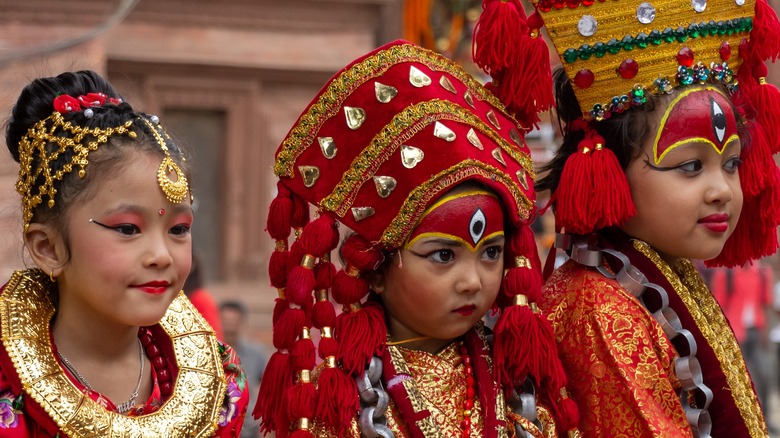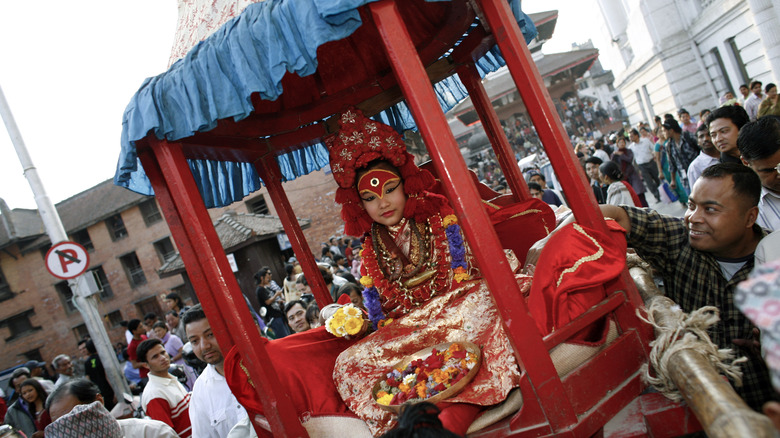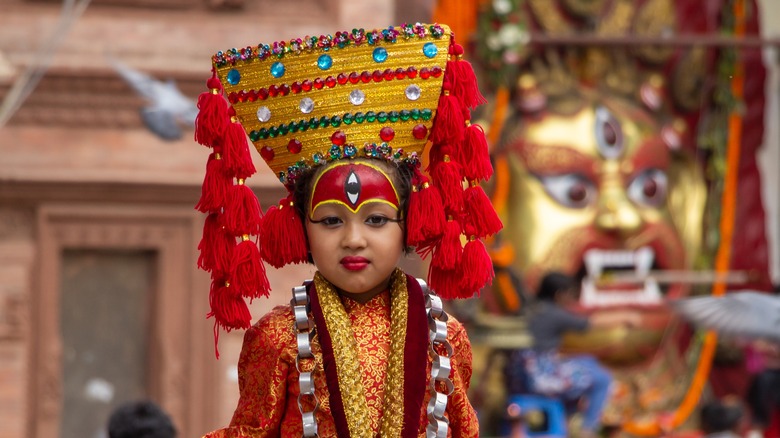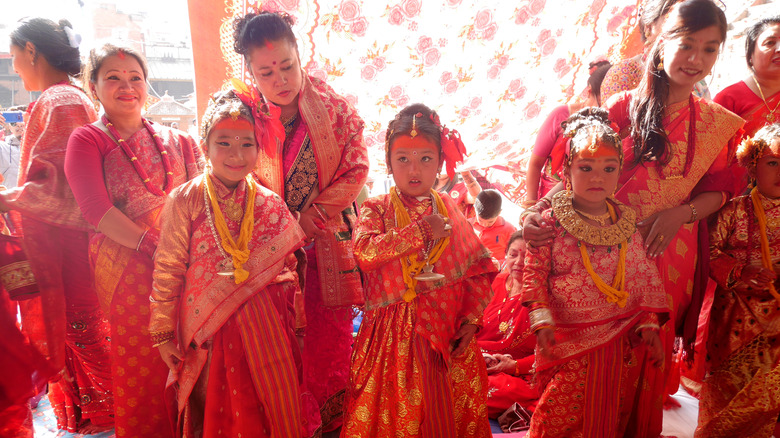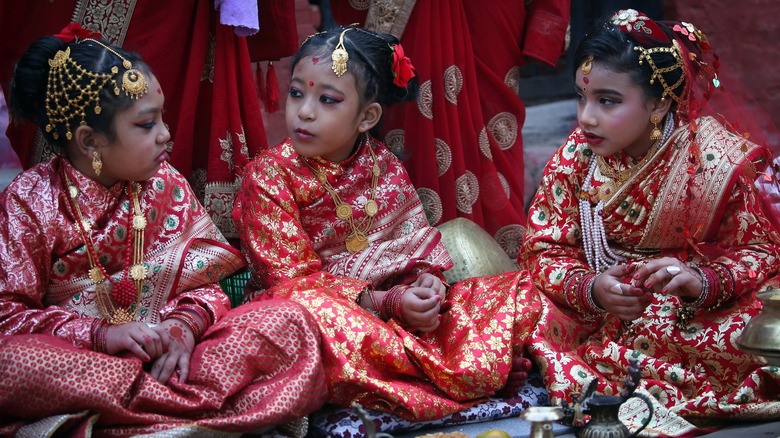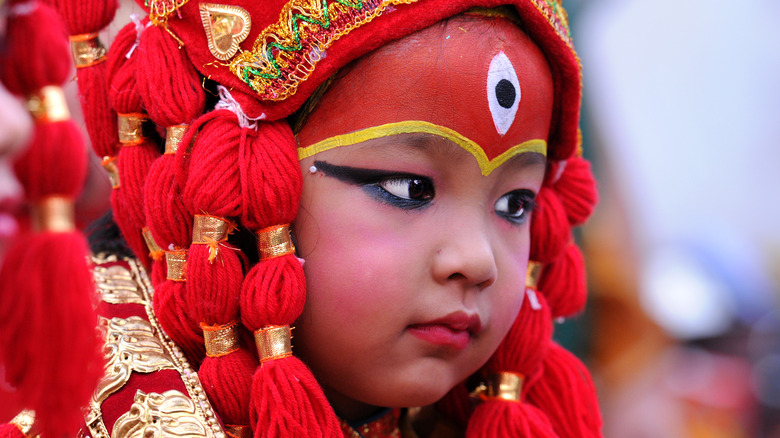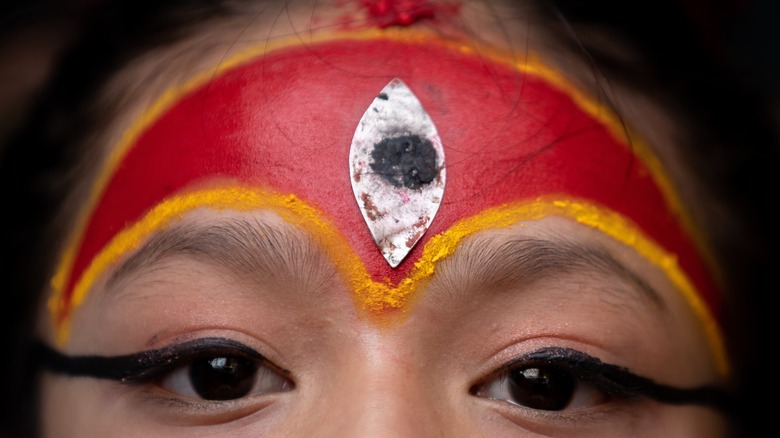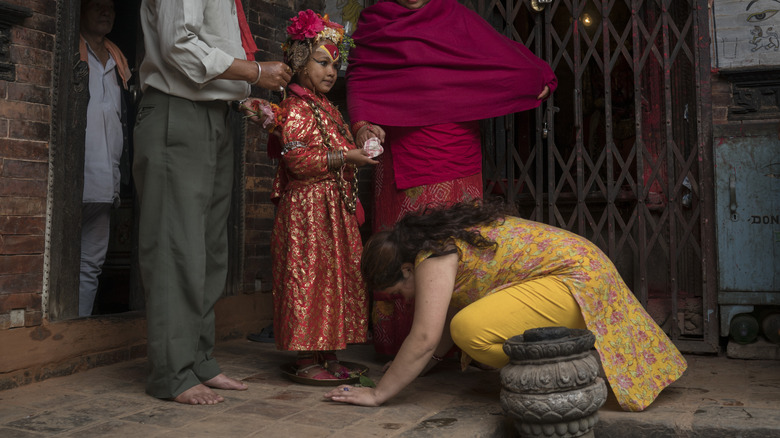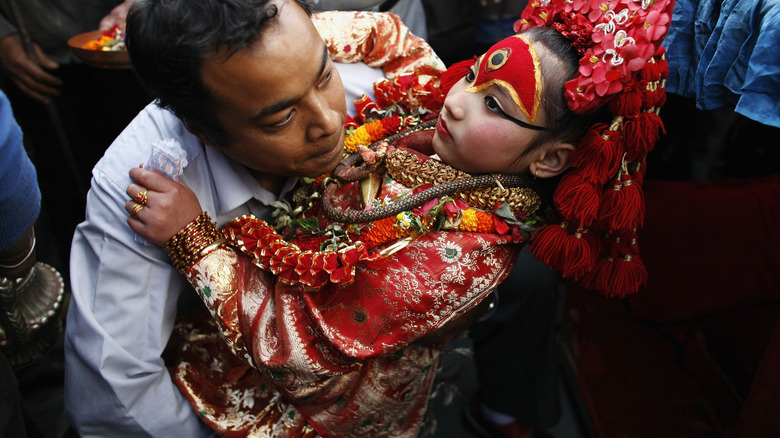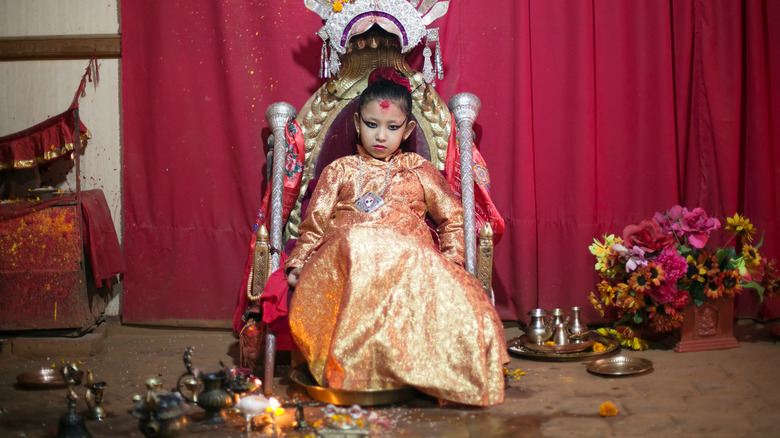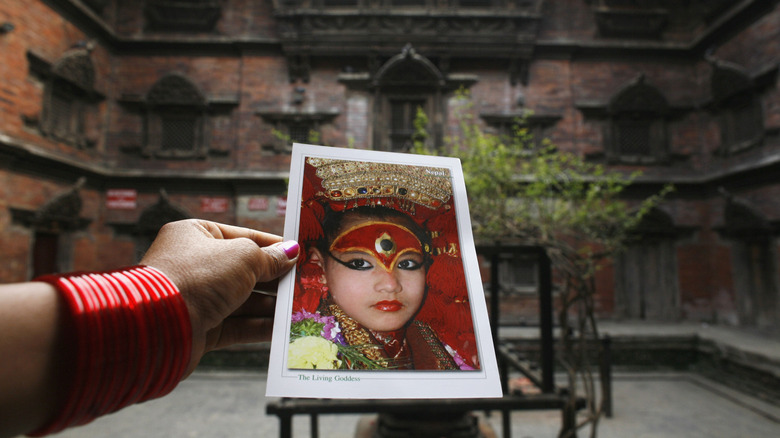What Life Is Like For The Child Goddesses Of Nepal
On April 25, 2015, a devastating magnitude 7.8 earthquake rocked Kathmandu, the capital and most populous city in Nepal (via Britannica and the Shenzhen Government Online). The massive tremor's center sat approximately 48 miles northwest of the metropolis, and two shattering aftershocks followed within less than 24 hours, measuring magnitude 6.6 and 6.7.
The quake and its aftershocks brought much of Durbar Square, Kathmandu's historic center (and a UNESCO World Heritage Site), crashing to the ground, according to National Public Radio (NPR). In contrast to this tragic loss of ancient palaces and temples, the home of Nepal's principal Living Goddess or Royal Kumari remained largely untouched except for a few minor cracks. While skeptical residents rationalized the preservation of her home as the result of its inherent sturdiness, devotees of the Kumari of Kathmandu had other ideas.
They argued that the Living Goddess' powers preserved the residence of the diminutive 9-year-old and her family. Udhav Man Karmacharya, a noted priest, argued, "It's the power of the goddess; it's about faith. It's been the home of Kumaris for ages and we believe the force of that goddess made the house safe." One thing's for sure: The earthquake brought to light a tradition that few in the West had previously encountered. Here's what you need to know about this centuries-old tradition and what it's like to be one of Nepal's child goddesses today.
They participate in a 300-year-old tradition
A succession of girls has acted as living goddesses since the 18th century, per ABC News. The process of selecting girls for incarnation as Durga, the intimidating Hindu goddess, represents an age-old tradition refined over the centuries, according to NPR. Myths abound about the origins of the Kumaris, but the most famous speaks of an ancient king of the Malla.
According to tradition, Durga visited this king every night, but then things went off the rails when he came onto her. Infuriated by his uncouth behavior, the goddess disappeared, no doubt in a "poof" of righteous fury. The king found himself utterly abandoned by the divine and not sure how to make amends. But Durga proved more patient than her fearsome reputation. Eventually, her anger cooled, and she appeared to the sovereign in a dream of mercy, directing him on how to hold communion with her once more.
As the story goes, she ordered the king, "Find a child from the Shakya caste. I will enter her soul and you can worship her as you worshipped me." Voila! The king followed the goddess' orders to a tee, selecting the first of the Living Goddesses from the girls of the city. Through her commands, Durga found a way to bridge the divide with the king (without facing further sexual advances). And she paved the way for a tradition that has persisted in Nepal for centuries, per The Washington Post.
Living goddesses start young
Nepal's living goddesses are chosen between the ages of three and six years old and continue in their roles until they reach puberty, per The Washington Post. They remain the contemporary embodiment of the legendary virgins Durga employed as vessels to visit the king and his descendants (via NPR). Today, a debate rages about whether the Living Goddesses have their childhoods stolen, according to ABC News.
After all, they begin public service when most girls are busy learning the alphabet and holding tea parties for their dolls. There are also questions about why the Kumaris remain locked away from the public eye throughout their childhoods and why they no longer serve after puberty. Priest Udhav Karmacharya offers matter-of-fact answers. Regarding the puberty question, he explains that Kumaris must remain devoted to their calling. This gets more difficult as the Living Goddesses age and become interested in relationships, more rigorous education, planning for future careers, and other external pressures.
What's more, he argues that older kids prove more likely to divulge the clandestine aspects (there are many) of being Living Goddesses. This could undermine the institution, rendering it commonplace. As Karmacharya explains, "There is information we cannot divulge. When she's conversing in the temple with the priests — she's god-like. It's a mystery. It's sacred. And if we tell all of the secrets, she'll no longer be a goddess, but just a common woman."
Kumaris go through a stringent selection process
Finding child goddesses is no simple matter, according to ABC News. It requires an elaborate process and inspection by the nation's highest priests. For example, the Royal Kumari is chosen every 10 years or so following a lengthy process that begins with a call for nominations from 16 of Kathmandu's monasteries.
Once nominations get received, the girls' zodiac birth charts or Jaatas are carefully examined. Potential nominees' star charts must align with those of the current national leader to advance to the next level. Once upon a time, that meant the king, but now it's the Nepalese president. From there, the pool of girls narrows based on 32 characteristics of physical perfection.
While only the high priests know what all of these characteristics are, they relate to ancient standards of beauty that sound rather unconventional today. For example, Kumaris must have eyelashes like a cow, thighs like a deer, and a chest like a lion, as reported by NPR. Former Kumari Preeti Shakya recalls examination by the royal priest's wife to ensure the perfection of her nails and teeth and that her body had no blemishes. But it's not all about looks alone. According to Gautam Shakya, a long-time caretaker of the Royal Kumari, "The girl has to be beautiful, then calm and not afraid."
Selected Kumaris face a terrifying initiation
Once a potential girl gets selected, a final initiation challenge looms, involving time spent in a dark and scary place (via ABC News). Priests remain mum about what's in this location, and Kumaris are chosen so young they have few (if any) memories of the experience. Nevertheless, we do know that it's imperative the Living Goddess not cry. Should her eyes well up with trepidation or tears, she's dismissed.
Entering the ominously titled "dark room of horror" happens eight days into the Dashain Festival. Former Kumari, Chanira Bajracharya, recalls, "Actually, the room was quite scary, only lit through oil lamps. But then when you get the power of the goddess, you don't get scared at all. Even though I was 5 years old, I was sitting there quite calm." And that's exactly the kind of counterintuitive response it takes to ascend to the ranks of Living Goddess. Only the calm and tranquil girls make the final cut.
These stoic ladies follow in a centuries-old tradition, assuming the role of divinity incarnate. After induction as Kumaris, the girls' experiences differ. The Royal Kumari of Kathmandu lives with the official Kumari caretakers at the Kumari Ghar. Her family is permitted to visit once a week, which likely helps with the intense sense of privacy surrounding the entire tradition. For the parents of the Kumari, relinquishing their daughters is painful but comes with great esteem and celebrity within the Newar community.
Multiple child goddesses serve at once
Although you might assume the earthly embodiment of the Hindu goddess, Durga, would be limited to one child at a time (like the Dalai Lama), there are actually 12 Kumaris who serve simultaneously in the Kathmandu Valley (via ABC News). They rank in a hierarchy of importance, with the Royal Kumari at the top. Nevertheless, all of the girls are deemed Living Goddesses.
Having multiple goddesses simultaneously serves many practical purposes. It permits them to be in multiple places at the same time, which is especially important when it comes to attending festivals throughout the year, as reported by The Washington Post. The Kumaris are thought to maintain stability within the nation. What's more, having many active Living Goddesses may keep locals invested in the practice since they're never that far away from one of the Kumaris. This has proven especially important in a period when the tradition faces increasing criticism.
As the world has evolved through technological advances, so has the position filled by the Kumaris. To assuage critics who argue that the Living Goddesses get robbed of their childhoods, the various Kumaris receive education while serving. They also have been granted more flexibility in recent years. For example, when Sajani Shakya served as a Living Goddess in the early 2000s, she became the first Kumari to visit the United States (via NPR).
Kumaris must come from the Newar community
Girl goddesses come from the Newars, an ethnic group native to the Kathmandu Valley, according to NPR. Throughout history, the Newars have been strongly influenced by India's social and religious institutions, and most are Hindu with a smaller Buddhist subset, per Britannica. More specifically, Durga demanded she be incarnated in the body of a girl from the Shakya family, members of the highest Newari caste.
All child goddesses are Buddhist, and in their incarnation as a Hindu goddess, they symbolize religious tolerance and harmony, per NPR. Former Kumari Preeti Shakya explains, "Everything is mixed in Nepal. Hindus and Buddhists live together, so our traditions meet with their traditions" (via ABC News). Some people even speculate that the Living Goddesses represent a hangover of a now-obsolete religious tradition specific to the Newars. Of course, bridging the gap between Buddhism and Hinduism is the figure of Siddhartha Gautama (a.k.a. the Buddha) himself. Originally a Hindu prince, he was born in Lumbini, a part of present-day Nepal.
As for the Kumari's support of Nepalese kings, this practice ended in December 2007 with the dissolution of the monarchy, as reported by NPR. The sovereign was replaced with a president. During this tumultuous transition, the Living Goddesses of Nepal demonstrated incredible staying power. Kumaris now bless other national political leaders like the president and prime minister, granting these political figures authority to rule with one touch of their childlike divinity.
Incarnation as Durga is a physical feeling
According to past Kumaris, the investiture process leads to incarnation as the Hindu goddess Durga, a state which persists throughout their youthful careers as Living Goddesses, per NPR. This state comes with physical symptoms, including a deep sense of calmness, lack of fear, physical warmth, and a generally pleasant feeling. Some also claim their bodies are literally taken over, and their behaviors are no longer their own. In some cases, this involves inexplicably granting the wishes of some while denying those of others.
According to former Kumaris, they don't understand the rhymes or reasons behind their own actions. Instead, they chalk their behavior up to something beyond themselves. Chanira Bajracharya, a former Living Goddess, remembers her experiences as Durga, stating, "My behavior is not in my control ... There is someone supreme over me that makes me listen to [some peoples'] prayers or just ignore them. You feel, you know, supreme. You're not you, actually."
Eyewitnesses like Gautam Shakya, caretaker of the Kumaris, confirm that Living Goddesses are far from your average little girls, according to ABC News. For example, they can sit patiently for six or seven hours straight, not something you'd expect from the age equivalent of preschoolers and kindergartners. He also argues that the Kumaris don't have to attend to basic needs as mere mortals would. This includes not needing to use the bathroom, eat, or rest for extraordinary lengths of time.
Living goddesses wear elaborate costumes and plenty of makeup
Embodying a living goddess requires looking the part, according to ABC News. This involves wearing elaborate red and gold costumes and matching makeup. This makeup includes a third eye painted on the Kumaris' foreheads, and they also wear layers of heavy jewelry and flowers. Red is considered the color of Durga, hence the theme of scarlet.
The special clothing isn't reserved solely for festivals and public appearances, either. Preeti Shakya remembers having to wear traditional clothing and makeup all day long. When not in the public eye, officials allowed her to don more modern dresses, but they still had to be red. Kumaris keep their hair styled in a topknot bun and secured with red cords gifted to them by their devotees (via NPR). One former Kumari, Samita Bhajracharya, relied on her mother, Shobha Bhajracharya, to apply the elaborate makeup she wore during public appearances, as reported by The World. Besides the fancy clothes and cosmetics, the Kumaris also sport layers of heavy and intricate armbands and necklaces.
The finished product reflects traditional images and statues depicting Durga (a.k.a. Shakti and Devi) in her gilded crimson glory, as reported by Britannica. Hindu mythology maintains that head honcho gods like Brahma, Shiva, and Vishnu collaborated in the creation of Durga. Her mission was to slay Mahishasura, the buffalo demon. So, fierce is the name of the game when it comes to a Kumari's public persona and outward appearance.
The perks of being Kumaris are undeniable
Kumaris enjoy undeniable perks, as reported by The World. As Living Goddesses, the world literally appears to revolve around them, and they get to enjoy things like having their parents worship them, according to NPR. Of course, others venerate them, too, including heads of state and religious leaders, so it's easy to see why Living Goddesses can start to develop pretty big heads (via NPR).
As former Kumari Chanira Bajracharya remembers, "Being a goddess is just like being a princess and you get everything at home. I never missed going outside, but rather enjoyed staying at home and being part of the divine life." They also tend to get spoiled rotten since it's hard to say "No" to a living goddess. This spoilage includes plenty of chocolate offerings and toys from faithful devotees (via ABC News).
The attention and gifts that Kumaris receive leave them feeling special and unique. At any given festival, thousands of pilgrims turn out to see them and seek their blessings. For example, at the Indra Jatra Festival, the masses descend to see Kumaris. They throw offerings at them and shout blessings in their direction. Despite all of these stimuli, the Living Goddesses remain calm and filled with deep-seated gravitas, denoting their divinity.
The rules are stringent for child goddesses
Rules remain incredibly stringent for child goddesses, according to The Washington Post. For example, they must never let their feet touch the ground, which means a childhood of getting carried. One-time Living Goddess Preeti Shakya recalls, "I wasn't allowed to step outside, and if I did, they used a traditional cloth kind of like a red carpet" for her to walk on (via ABC News). This means re-learning how to walk as an adolescent.
They also rise early for veneration by pilgrims and cultivate a decidedly unchildlike patience when seated on their thrones. There, they spend hours blessing passers-by, receiving offerings, and permitting followers to touch their feet. They can't eat chicken or eggs, and the same goes for pork, according to NPR.
But not all Kumaris receive the same treatment. In 2007, a Living Goddess named Sajani Shakya became the first one to visit the United States. There, she met with schoolchildren to educate them about her life, and she also participated in the American Film Institute's Silverdocs film festival, where a documentary featuring her and two other Kumaris premiered, titled "Living Goddesses." Besides international travel, Sajani Shakya has also savored other liberties generally not allotted to most Kumaris, like living with her family and going outside on occasion.
The Living Goddess lifestyle ends at puberty
Kumaris must be pre-pubescent virgins because menstruation is seen as a change of life and exclusion from divinity, according to The Washington Post. Menstrual blood is considered unclean and non-divine, meaning the goddess can no longer dwell within the girls once they hit puberty. Around the age of 11, officials start looking for the Living Goddess' replacement (via ABC News).
As Deepak Bahadur Pandey, a senior official, explains, "If we don't change her now, we'll have to wait until next year, which could be late. If the girl starts menstruating while serving as Kumari, it is considered inauspicious."
After a former Living Goddess starts menstruating and is replaced, she must submit to a special ceremony, per The World. It involves 12 days of isolation, locked away from the world. During that time, no men may enter her presence, but she can be visited by female friends and relatives. After the prescribed time is completed, she steps outside to face the real world. Of course, retiring from life as a venerated being comes with a new set of challenges.
The transition from goddess to teen isn't easy
Kumaris inhabit lives of isolation and devotion, per The World. Their existences are secretive, and they're rarely seen outside (except at festivals). They only speak with immediate family members, close friends, and caretakers. They dedicate themselves to prayer and study with private tutors. After years spent being carried everywhere, worshipped as divine, and lavished with attention, Kumaris face life as mere mortals once more (via ABC News). The learning curve proves steep.
The hardest part can be dealing with the scrutiny and criticism regular kids face. While Preeti Shakya's family helped with her transition by easing off the goddess treatment over time, she enjoyed no such luck when it came to treatment outside of the home. As Shakya recalls, "Teachers started scolding me as I was a little poor in my studies, and when I first went to school, one of my classmates said I look so fat. At that time, I was completely broken because nobody used to talk in that manner." Fortunately, Shakya soon found things she liked, too, like making new friends and exploring new places.
Other former Kumaris share similar stories, including Chanira Bajracharya, who reports the other kids at school initially felt intimidated by her. She also had to learn to walk properly at the age of 15 with the help of her parents, who held her hands. Naturally, dismounting the goddess high horse involves some hard knocks. Nevertheless, the teens bounce back with Durga-like resilience.
